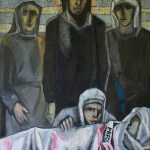
The peoples of the world have created, on their creative path of civilization, expressions for their conceptions of thought, in the form of symbols and rituals which were clearly expressed by the erection of temples, places of worship, obelisques and stone monuments. In the wake of the march of humanity, and in the course of generations, these structures may have become symbols and epitomes of a past world relapsed in the passage of time, but were not entirely erased. Generations follow each other, leaving at every stage memories which cling to the present. These relics reach me in waves of sadness, through the uprightness of the palm-tree: the depth of the cactus root, a towering forsaken mosque or rusty church bell which no longer resound through the atmosphere.
I feel the wounds of this sequence of not-distant history, and its suffering: the rocky surfaces of brown stones lying in front of the bulldozers of “progress”, and have tasted its salinity like that streaming over a dark forehead; the sweat that, through history, laden with bitterness, was transformed to heavy tears dripping over tombstones that have become monuments in the villages of Sakhneen, Kfar Qassem, Tantoura and Dir-Yassin.
The monument we have erected in Sakhneen can be the witness and the vow of its eternal belonging to this land, which pleaded to its sons to rise in defence of their mother earth. Our common work, the work of my colleague Gershon Knispel and myself, is an embodiment of the idea of creative cooperation between the two peoples to present repetition of the tragedy, and to make our present efforts hand over to the future monuments of peace and mutual co-existence in this land.
From the “Land Day Monument: Catalogue” (1978), photography of monument: Gideon Gitai.



















